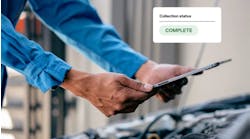Led by Munich-based engineering firm Siemens, the first 6-mile stretch of electric highway south of Frankfurt on Germany’s A5 autobahn was opened last week. One truck, provided by Volkswagen’s Scania truck unit, is using it now, with four more planned by 2020.
According to Siemen’s eHighway brochure, the key innovation is the active pantograph, capable of connecting while driving at any highway speed, estimating more than 80% efficiency level with overhead contact lines. Siemen’s goal is to reduce the use of fossil fuels and truck operating costs, at the same time eliminating local emissions such as CO2 and nitrogen oxides.
The system is broken down into three parts: Energy supply, the pantograph, and hybrid drive technology.
Energy supply
The energy supply system is based on proven technology from the world of railroad electrification. The two-pole catenary system ensures a reliable energy supply for the eHighway truck. The catenary system leads to a level contact wire that enables stable current transmission, even at high speeds.
The overhead contact lines are supplied with energy from substations equipped with:
- Medium voltage switchgear
- Power transformers
- Rectifiers
- Controlled inverters (for feedback of the electric energy generated by the vehicles’ regenerative braking).
Pantograph
The active pantograph transmits the energy from the overhead contact lines to the electric motor of the eHighway truck. The pantograph can be easily connected to and disconnected from the contact wire at speeds ranging from 0 to 90 km/h. This is done either automatically or manually at the push of a button.
According to Siemens, steering an eHighway truck connected to the overhead contact lines is no different to driving a diesel truck, as the active pantograph compensates for any shifts in position within the lane. The pantograph automatically disconnects in the event of evasive maneuvers or if the indicators are used.
Hybrid drive
On electrified routes, the electric motors in eHighway trucks are powered by the overhead contact lines and the active pantograph. For remaining sections of road, the eHighway truck has a hybrid drive.
According to Siemens, there are no restrictions on the type of hybrid drive: depending on the application and customer requirements, serial and parallel concepts with internal combustion engines, battery solutions, fuel cells etc. can all be implemented. The electric motors of the eHighway trucks also enable recovery of the vehicle’s braking energy.
Back in 2016, similar tests of the eHighway technology have been conducted on a smaller scale in Sweden and near the U.S. ports of Los Angeles and Long Beach. An almost two mile stretch north of Stockholm aims to evaluate options for Electric Road Systems prior to introduction on the Swedish road network. The trials are executed with two diesel hybrid vehicles manufactured by Scania and adapted, in collaboration with Siemens, to operate under the catenary system.
A public road demonstration of the eHighway system in Southern California, using a one mile-long road with contact lines going in both directions, will collect data and evaluate the benefits of eHighway operations for the area, especially for the intensely used road freight operations connecting the nearby ports of Los Angeles and Long Beach with local rail yards. The potential of reducing local air pollution is a major motivator for realizing the project in Southern California.




